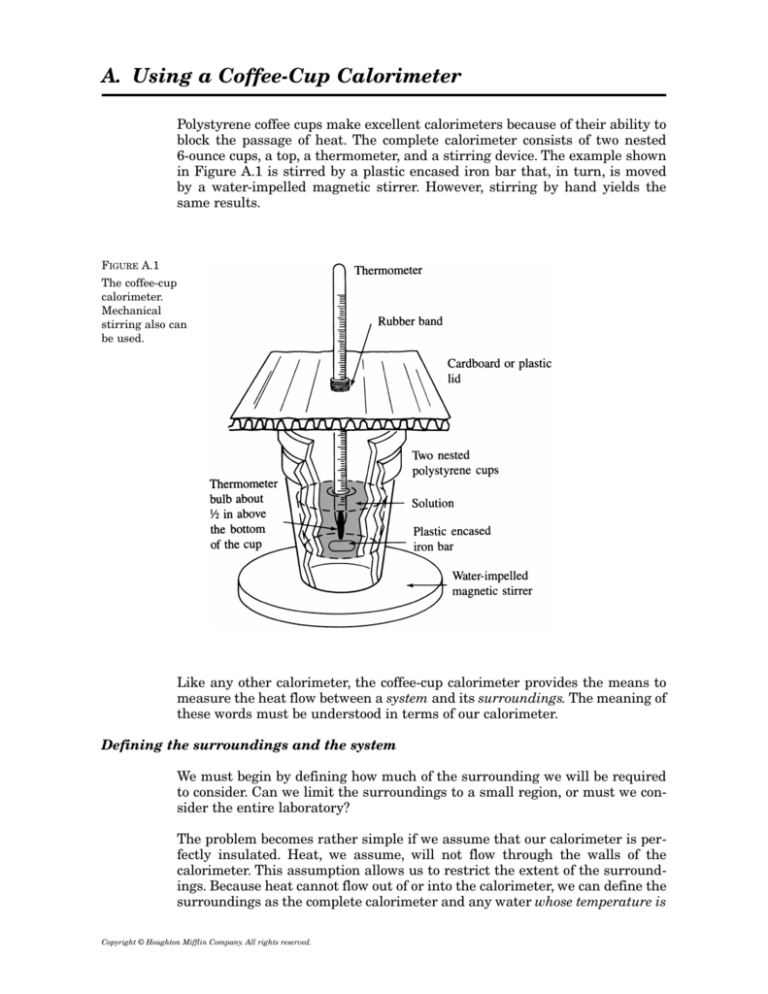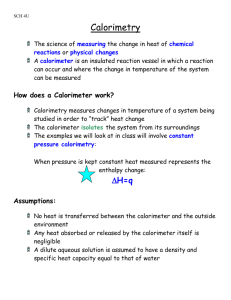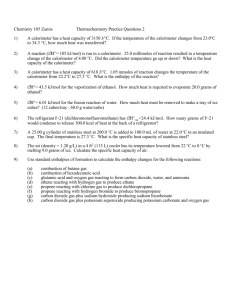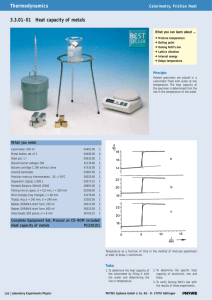
A. Using a Coffee-Cup Calorimeter
Polystyrene coffee cups make excellent calorimeters because of their ability to
block the passage of heat. The complete calorimeter consists of two nested
6-ounce cups, a top, a thermometer, and a stirring device. The example shown
in Figure A.1 is stirred by a plastic encased iron bar that, in turn, is moved
by a water-impelled magnetic stirrer. However, stirring by hand yields the
same results.
FIGURE A.1
The coffee-cup
calorimeter.
Mechanical
stirring also can
be used.
Like any other calorimeter, the coffee-cup calorimeter provides the means to
measure the heat flow between a system and its surroundings. The meaning of
these words must be understood in terms of our calorimeter.
Defining the surroundings and the system
We must begin by defining how much of the surrounding we will be required
to consider. Can we limit the surroundings to a small region, or must we consider the entire laboratory?
The problem becomes rather simple if we assume that our calorimeter is perfectly insulated. Heat, we assume, will not flow through the walls of the
calorimeter. This assumption allows us to restrict the extent of the surroundings. Because heat cannot flow out of or into the calorimeter, we can define the
surroundings as the complete calorimeter and any water whose temperature is
Copyright © Houghton Mifflin Company. All rights reserved.
initially identical to that of the calorimeter. Later, we will find a way to correct
for imperfect insulation without altering our definition of the surroundings.
The system includes any other substance or substances that are contained in
the calorimeter. This definition of a system includes substances that are dissolved in the water, such as the reactants and products of a chemical reaction.
It also includes other portions of water whose temperature is not initially identical to the temperature of the calorimeter.
An equation for heat flow
The equation that describes heat flowing between a system and its surroundings is
q(system) 5 2q(surroundings)
This equation states that heat lost (or gained) by a system, q(system), is equal
to heat gained (or lost) by the surroundings, 2q(surroundings). Clearly,
q(system) and q(surroundings) must have opposite signs, because as heat is
lost by one, it is gained by the other.
Because of our definition of the surroundings, the equation for heat flow
becomes
q(system) 5 2q(water) 2 q(calorimeter)
The following equations show how the heat gained or lost by the water and the
calorimeter, q(water) and q(calorimeter), can be calculated:
q(water) 5 sp. ht. 3 mass of H2O 3 (tf 2 ti)
q(calorimeter) 5 C 3 (tf 2 ti)
where sp. ht. is the specific heat, C is the heat capacity of the calorimeter, tf is
the final temperature, and ti is the initial temperature. We will take the specific heat to be that of pure water, 4.184 J/(g • 8C). Unless we are dealing with
pure water, however, this is only an approximation. When substances are dissolved in the water, its specific heat is altered somewhat. We will also take the
heat capacity of the calorimeter to be 1.0 3 101 J/8C.
An example
Suppose the temperature of 50 mL of 1.0 M NaOH in a coffee-cup calorimeter
is 25.38C. When 50 mL of 1.0 M HCOOH (formic acid), whose temperature is
also 25.38C, is added to the calorimeter, the temperature increases to 31.88C.
The chemical reaction is
NaOH 1 HCOOH l NaHCOO 1 H2O
The density of the final solution can be taken to be 1.0 g/mL. We will identify
the surroundings and the system and then calculate q(system).
The surroundings are the complete calorimeter and all the water from both of
the original solutions. Note that this water and the calorimeter share the same
Copyright © Houghton Mifflin Company. All rights reserved.
temperature. Thus the demands of our definition of the surroundings are met.
The mass of this water is
(50 1 50) mL 3 1.0 g/mL 5 1.0 3 102 g
The system becomes the reactants and products of the chemical reaction, including the quantity of water that is formed in the reaction.
We will now calculate q(water) and q(calorimeter) from our equation for heat
flow. We will use 4.184 J/(g • 8C) as the specific heat of water and 1.0 3 101 J/8C
as the heat capacity of the coffee-cup calorimeter.
q(water) 5 4.184 J/(g • 8C) 3 1.0 3 102 g 3 (31.8 2 25.3)8C
5 2.7 3 103 J
q(calorimeter) 5 1.0 3 101 J/8C 3 (31.8 2 25.3)8C
5 65 J
Then
q(system) 5 2q(water) 2 q(calorimeter)
5 22.7 3 103 J 2 65 J
5 22.8 3 103 J or 22.8 kJ
Enthalpy changes
Enthalpy changes can be calculated by dividing q(system) by the number of
moles of the limiting reactant. In our example, we have for each reactant
50 mL 3 1 L/103 mL 3 1.0 mol/L 5 5.0 3 1022 mol
The enthalpy change becomes
DH 5 22.8 kJ/5.0 3 1022 mol 5 256 kJ/mol
Correcting for imperfect insulation
The equation for heat flow was obtained using the assumption that our
calorimeter is perfectly insulated. We must now recognize that this assumption is not warranted, because heat will flow through the walls. After all, hot
coffee in a polystyrene coffee cup cools even if the top is covered.
Because heat leaks through the walls, we will not be able to observe the highest (or lowest) temperature that could have been achieved in a perfectly insulated calorimeter. However, we need to know that temperature, because it is tf
in our equation for heat flow.
We will estimate that temperature by plotting temperature as a function of
time. We will then extrapolate to the time at which the solutions were mixed.
This temperature is tf . A typical result is shown in Figure A.2, which indicates
how a final temperature of 31.88C was estimated in the preceding example.
Copyright © Houghton Mifflin Company. All rights reserved.
Note, however, that the rate and method of stirring affect the appearance of
this graph.
FIGURE A.2
A graph showing
the temperature
as a function of
time after 50 mL
of 1.0 M NaOH
and 50 mL of
1.0 M HCOOH
are mixed.
Copyright © Houghton Mifflin Company. All rights reserved.







